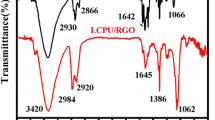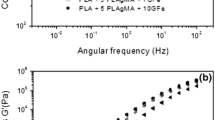Abstract
Polydimethylsiloxane (PDMS) and graphene-PDMS nanocomposites (GP) have been widely studied because of their excellent properties, of which the elastic modulus is very important for various applications. Here, the dependence of the elastic modulus of properly cured PDMS and GP on the temperature has been investigated. For both PDMS and GP, a critical temperature (Tc) has been found, which originates from the strong affinity of PDMS chains to the PDMS network and graphene sheet, as suggested by molecular dynamics simulation. Graphene inhibits the cross-linking of PDMS close to its surface, which leads to the reduced elastic modulus of GP (EGP). Only when the temperature is above Tc, EGP increases with temperature. This is the result of the entropy elasticity of PDMS and the re-initiated cross-linking of PDMS. However, the elastic moduli of PDMS and GP are independent of the temperature below Tc. Here, the study provides a guideline for the preparation and using of PDMS and its composite at various temperatures.







Similar content being viewed by others
References
Jiang W, Niu D, Liu H et al (2014) Photoresponsive soft-robotic platform: biomimetic fabrication and remote actuation. Adv Funct Mater 24:7598–7604
Hu Y, Wu G, Lan T, Zhao J, Liu Y, Chen W (2015) A graphene-based bimorph structure for design of high performance photoactuators. Adv Mater 27:7867–7873
Yan C, Wang J, Lee PS (2015) Stretchable graphene thermistor with tunable thermal index. ACS Nano 9:2130–2137
Zdrojek M, Bomba J, Łapińska A et al (2018) Graphene-based plastic absorber for total sub-terahertz radiation shielding. Nanoscale 10:13426–13431
Boland CS, Khan U, Ryan G et al (2016) Sensitive electromechanical sensors using viscoelastic graphene–polymer nanocomposites. Science 354:1257–1260
Zhang Y, Zhu Y, Lin G, Ruoff RS, Hu N, Schaefer DW, Mark JE (2013) What factors control the mechanical properties of poly(dimethylsiloxane) reinforced with nanosheets of 3-aminopropyltriethoxysilane modified graphene oxide? Polymer 54:3605–3611
Zhao YH, Zhang YF, Bai SL (2016) High thermal conductivity of flexible polymer composites due to synergistic effect of multilayer graphene flakes and graphene foam. Compos Part A Appl Sci Manuf 85:148–155
Wolf MP, Salieb-Beugelaar GB, Hunziker P (2018) PDMS with designer functionalities—properties, modifications strategies, and applications. Prog Polym Sci 83:97–134
Fang M, Zhang Z, Li J, Zhang H, Lu H, Yang Y (2010) Constructing hierarchically structured interphases for strong and tough epoxy nanocomposites by amine-rich graphene surfaces. J Mater Chem 20:9635–9643
Terrones M, Martín O, González M, Pozuelo J, Serrano B, Cabanelas JC, Vega-Díaz SM, Baselga J (2011) Interphases in graphene polymer-based nanocomposites: achievements and challenges. Adv Mater 23:5302–5310
Cao L, Wang Y, Dong P, Vinod S, Tijerina JT, Ajayan PM, Xu Z, Lou J (2016) Interphase induced dynamic self-stiffening in graphene-based polydimethylsiloxane nanocomposites. Small 12:3723–3731
Xue L, Sanz B, Luo A et al (2017) Hybrid surface patterns mimicking the design of the adhesive toe pad of tree frog. ACS Nano 11:9711–9719
Guo Q, Luo Y, Liu J, Zhang X, Lu C (2018) A well-organized graphene nanostructure for versatile strain-sensing application constructed by a covalently bonded graphene/rubber interface. J Mater Chem C6:2139–2214
Jesson DA, Watts JF (2012) The interface and interphase in polymer matrix composites: effect on mechanical properties and methods for identification. Polym Rev 52:321–354
Li Q, Liu C, Lin YH, Liu L, Jiang K, Fan S (2015) Large-strain, multiform movements from designable electrothermal actuators based on large highly anisotropic carbon nanotube sheets. ACS Nano 9:409–418
Wang W, Xiang C, Zhu Q, Zhong W, Li M, Yan K, Wang D (2018) Multistimulus responsive actuator with go and carbon nanotube/pdms bilayer structure for flexible and smart devices. ACS Appl Mater Int 10:27215–27223
Stankovich S, Dikin DA, Dommett GHB et al (2006) Graphene-based composite materials. Nature 442:282–286
Papageorgiou DG, Kinloch IA, Young RJ (2017) Mechanical properties of graphene and graphene-based nanocomposites. Prog Mater Sci 90:75–127
Wu ZS, Ren W, Gao L, Liu B, Jiang C, Cheng HM (2009) Synthesis of high-quality graphene with a pre-determined number of layers. Carbon 47:493–499
Casiraghi C, Hartschuh A, Qian H et al (2009) Raman spectroscopy of graphene edges. Nano Lett 9:1433–1441
Malard LM, Pimenta MA, Dresselhaus G, Dresselhaus MS (2010) Raman spectroscopy in graphene. Phys Rep 473:51–87
Khan U, O’Neill A, Lotya M, De S, Coleman JN (2010) High-concentration solvent exfoliation of graphene. Small 6:864–871
Wang Y, Yang R, Shi Z, Zhang L, Shi D, Wang E, Zhang G (2011) Super-elastic graphene ripples for flexible strain sensors. ACS Nano 5:3645–3650
Camino G, Lomakin SM, Lazzari M (2001) Polydimethylsiloxane thermal degradation. Part 1. Kinetic aspects. Polymer 42:2395–2402
Zhang W, Srivastava I, Zhu YF, Picu CR, Koratkar NA (2009) Heterogeneity in epoxy nanocomposites initiates crazing: significant improvements in fatigue resistance and toughening. Small 5:1403–1407
Rafiee MA, Rafiee J, Srivastava I, Wang Z, Song H, Yu ZZ, Koratkar N (2010) Fracture and fatigue in graphene nanocomposites. Small 6:179–183
Asi O (2008) Mechanical properties of glass–fiber reinforced epoxy composites filled with Al2O3 particles. J Reinf Plast Compos 28:2861–2867
Liang J, Huang Y, Zhang L, Wang Y, Ma Y, Guo T, Chen Y (2009) Molecular-level dispersion of graphene into poly(vinyl alcohol) and effective reinforcement of their nanocomposites. Adv Funct Mater 19:2297–2302
Doi M, Edwards SF (1986) The theory of polymer dynamics. Oxford University Press, New York
Mark JE (2004) Some interesting things about polysiloxanes. Acc Chem Res 37:946–953
Xue L, Pham JT, Iturri J, del Campo A (2016) Stick–slip friction of PDMS surfaces for bioinspired adhesives. Langmuir 32:2428–2435
Yilgör E, Yilgör I (2014) Silicone containing copolymers: synthesis, properties and applications. Prog Polym Sci 39:1165–1195
Acknowledgements
Authors thank Dr. Rakesh Das for the language editing of this article. The research was funded by National Key R&D Program of China (2018YFB1105100, 2016YFA0200200) and National Natural Science Foundation of China (51503156, 51973165).
Author information
Authors and Affiliations
Corresponding author
Ethics declarations
Conflict of interest
The authors declare no conflict of interest.
Additional information
Publisher's Note
Springer Nature remains neutral with regard to jurisdictional claims in published maps and institutional affiliations.
Electronic supplementary material
Below is the link to the electronic supplementary material.
Rights and permissions
About this article
Cite this article
Wang, X., Shi, Z., Meng, F. et al. Interfacial interaction-induced temperature-dependent mechanical property of graphene-PDMS nanocomposite. J Mater Sci 55, 1553–1561 (2020). https://doi.org/10.1007/s10853-019-04126-y
Received:
Accepted:
Published:
Issue Date:
DOI: https://doi.org/10.1007/s10853-019-04126-y




